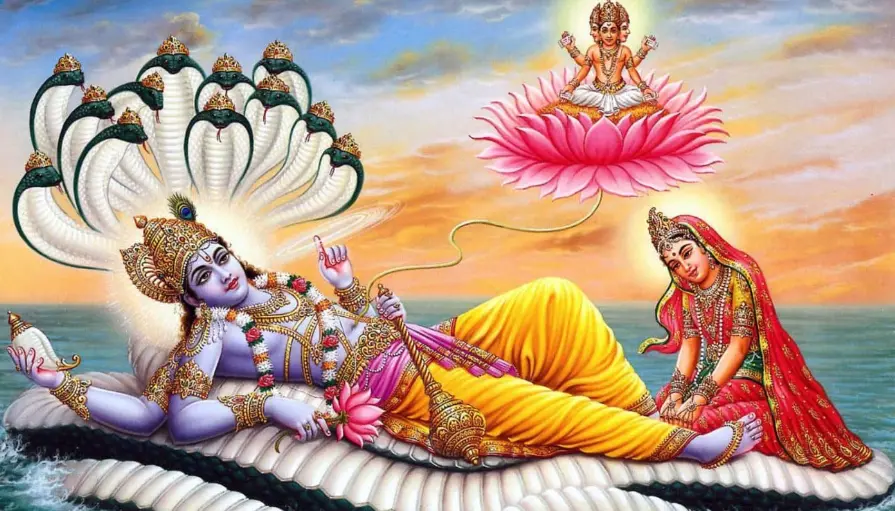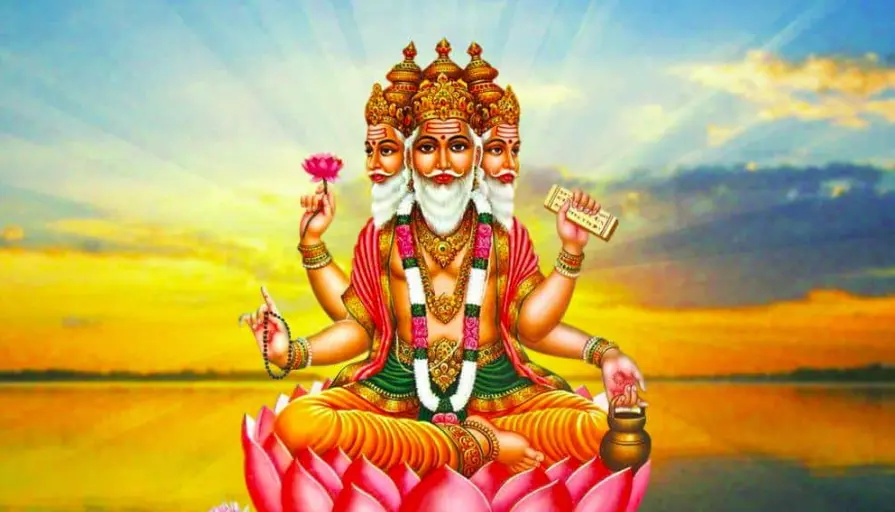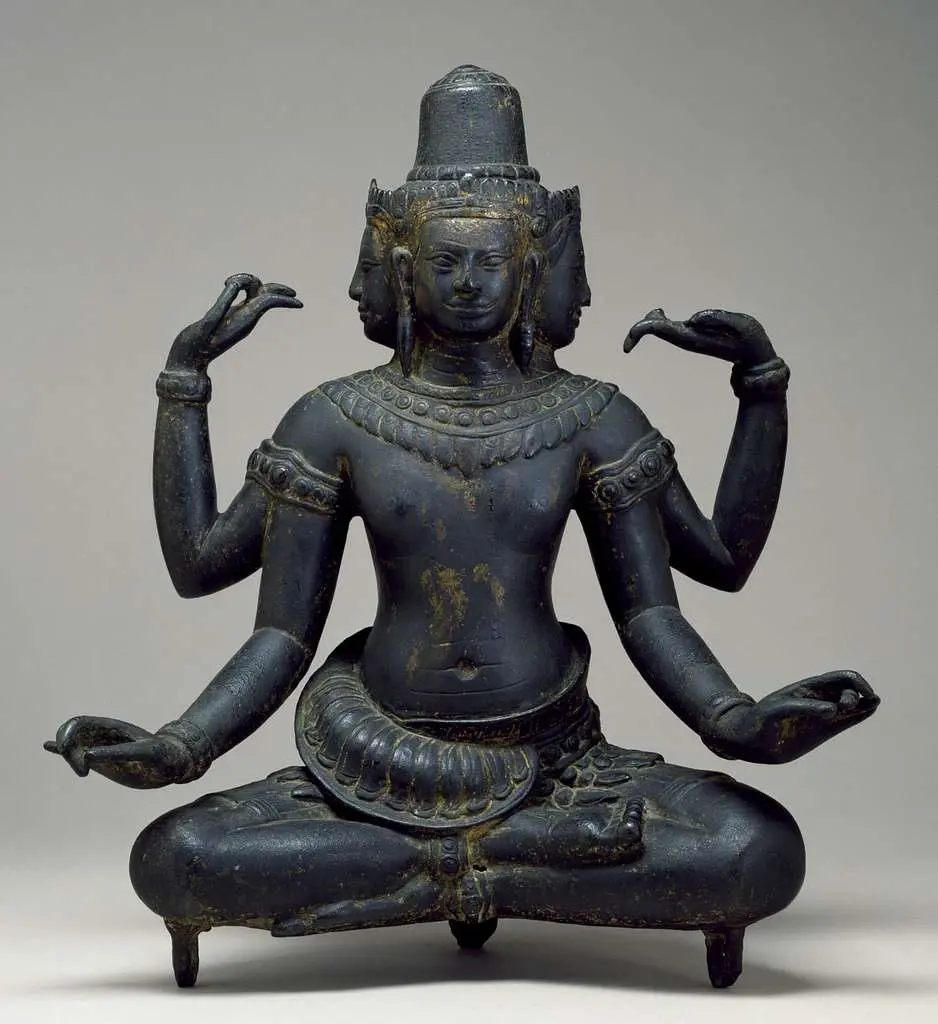Who is Lord Brahma, Origin and meaning of brahma
Lord Brahma, a revered figure in Hinduism, is regarded as the mastermind behind the creation of the universe. He holds a place of great significance in the Hindu divine realm, standing alongside Lord Vishnu and Lord Shiva as one of the three prominent deities. Lord Brahma is commonly portrayed with four arms and four faces and is often depicted seated on a lotus blossom.
In Hindu mythology, it’s said that Lord Brahma sprouted from a lotus that bloomed from Lord Vishnu’s navel. He’s mainly known as the creator of the universe and every living creature, and he is also thought to be the wellspring of all wisdom and knowledge.

Lord Brahma holds a significant place in Hinduism for various reasons. Firstly, he’s recognized as the creator of the universe and all living things, making him a pivotal figure in Hindu mythology and cosmology. Secondly, Lord Brahma is believed to be the fount of all wisdom and knowledge. He is frequently depicted holding a manuscript or book, representing the knowledge he has created and shared with the world. Thirdly, Brahma is linked with the practice of meditation and contemplation. He meditated for thousands of years before creating the universe, which inspires those seeking spiritual enlightenment.
Although Lord Brahma holds a significant position in Hinduism, he isn’t worshipped as commonly as Lord Vishnu or Lord Shiva. The reason behind this is that, while Brahma is the creator of the universe, he’s not responsible for maintaining or destroying it. Lord Vishnu, on the other hand, is known as the preserver of the universe and Lord Shiva as its destroyer. Since Brahma is believed to have accomplished his task of creation, he’s not worshipped as actively as the other deities.
The vehicle (vahana) of Lord Brahma, the creator in Hindu mythology, is a divine swan, or hansa. This vehicle of Lord Brahma is often depicted accompanying Brahma and is believed to symbolize purity, wisdom, and grace. The swan represents the ability to discern between good and evil, as well as the power of discrimination and discernment, qualities essential for creation and maintaining cosmic order.
Table of Contents
Exploring the significance of brahma & the Surrounding Lord Brahma
Lord Brahma in Hinduism is represented with complex and fascinating symbolism surrounding him. One of the most intriguing aspects of the life of Lord Brahma is his connection to the lotus flower. According to Hindu scriptures, Lord Brahma emerged from a lotus flower that grew from Lord Vishnu’s navel. This flower symbolizes purity and detachment from the material world, reflecting Brahma’s role as the creator of the universe. Legend has it that Lord Brahma meditated on the lotus flower for thousands of years before beginning the process of creation.
Lord Brahma’s four heads and four arms are a significant aspect of his mythology and symbolism in Hinduism. Each head represents a unique aspect of creation: the mind, intellect, ego, and consciousness, while his four arms are associated with the four Vedas, the sacred texts of Hinduism. This symbolism emphasizes Lord Brahma’s role as the creator and guardian of knowledge and wisdom. Understanding the significance of his multiple heads and arms can help one gain a deeper appreciation for Lord Brahma’s importance in Hindu mythology.

Lord Brahma’s importance as the creator of the universe is undeniable, yet he is not as widely worshipped as other major Hindu deities like Lord Vishnu and Lord Shiva. The complexity of his mythology and the belief that his role as creator is complete have contributed to this. Additionally, in some Hindu traditions, Lord Brahma is believed to have lost favor due to his association with the ego and worldly desires. Nonetheless, Lord Brahma remains a significant deity in Hinduism and is revered for his role in the creation and preservation of the universe.
Lord Brahma is one of the most fascinating and complex deities in Hindu mythology, with many intriguing stories surrounding his creation and role as the creator of the universe. One of the most captivating stories is that of his fifth head, which he grew out of his desire to better admire the goddess Saraswati, the embodiment of knowledge and wisdom. However, Saraswati did not return his affection, and the story serves as a cautionary tale about the dangers of allowing desires and attachments to take control of us. Explore the rich symbolism and mythology of Lord Brahma to gain a deeper understanding of his significance in Hinduism.
Lord Brahma’s rich mythology and symbology are reflected in the various rituals and practices associated with his worship. One such example is his worship during the Navratri festival, which celebrates the triumph of good over evil. Devotees offer flowers, incense, and sweets to Lord Brahma during this festival while reciting hymns and prayers in his honor. The festival also includes various cultural and musical events that pay homage to Lord Brahma’s role as the creator and custodian of knowledge and wisdom.
Lord Brahma’s mythology and symbolism are not limited to the lotus flower and the Vedas alone. He is also associated with other significant symbols and elements in Hindu mythology. Lord Brahma is often depicted riding a swan, which represents spiritual purity and detachment from material desires. Moreover, he is linked with the color red, which symbolizes creation and passion.
Exploring Lord Brahma’s origin and meaning
The creation story of Lord Brahma, as described in Hindu scriptures, starts with the void known as “Brahman.” It is believed that Lord Brahma emerged from this vast emptiness and was the first living being to come into existence. With his immense wisdom and supernatural powers, Brahma embarked on a journey to create the universe in several stages.

In the first stage of creation, Lord Brahma created the fundamental elements that make up the universe: earth, water, fire, air, and ether. These elements were then used to form the building blocks of the universe, including the stars, planets, and galaxies.
After creating the physical universe, Lord Brahma proceeded to create life. He fashioned all living beings, from the tiniest microorganisms to the largest animals, and bestowed upon them the gift of consciousness and intelligence. He also created celestial beings, such as gods, goddesses, and other divine beings, to oversee and govern various aspects of the universe.
One of the best-known stories linked to Lord Brahma’s creation is the tale of Prajapati. In this story, Brahma produces the first human being, a man named Prajapati. However, Prajapati becomes so engrossed in his own desires that he begins to forget his own identity and his creator. To make him aware of his divine origins, Brahma manifests himself before Prajapati as a swan, and Prajapati becomes conscious of his wrongdoing.
Another story linked to Lord Brahma’s creation is the tale of Brahma and Saraswati. As per this story, Brahma created the goddess Saraswati, who symbolizes knowledge and wisdom. He was so captivated by her charm and intellect that he grew a fifth head to better appreciate her. However, Saraswati did not reciprocate his feelings and ran away from him. Eventually, Brahma understood that his love for Saraswati was misplaced, and he shifted his focus to creating the universe.
The Different Forms and Manifestations of Lord Brahma
In Hindu scriptures, Lord Brahma is depicted in various forms and manifestations, each symbolizing a distinct trait and ability. We will explore the most noteworthy avatars and manifestations of Lord Brahma.
1. Chaturmukha Brahma
One of the most widely recognized depictions of Lord Brahma is in the form of Chaturmukha Brahma. This form is characterized by four faces, each oriented in a different direction, and four arms, symbolizing the four Vedas. Chaturmukha Brahma is closely associated with the creation of the universe and is frequently portrayed seated on a lotus blossom.
2. Virinchi Brahma
Virinchi Brahma is a notable incarnation of Lord Brahma in Hindu mythology. According to legend, he originated from a lotus flower that emerged from Lord Vishnu’s navel. This form of Lord Brahma has four faces, symbolizing the four Vedas, and his skin is a resplendent gold. Virinchi Brahma is closely associated with the creation of the cosmos and is often depicted holding a water pot and a rosary.
3. Purusha Brahma
Purusha Brahma is an intriguing incarnation of Lord Brahma, closely associated with the concept of the “cosmic man” or “universal self.” As the embodiment of the entire cosmos, Purusha Brahma is typically depicted as a colossal figure with innumerable arms and legs that represent all living beings. This form of Lord Brahma is deeply connected to the creation of the universe and is believed to be the origin of all life.

4. Svayambhuva Brahma
Svayambhuva Brahma is a noteworthy form of Lord Brahma in Hinduism. Legend has it that he emerged self-born from a lotus flower that bloomed from Lord Vishnu’s navel. This incarnation of Lord Brahma has four heads and four arms, carrying a book, a staff, a lotus flower, and a water pot. Svayambhuva Brahma is closely linked to the creation of the cosmos and is regarded as the fount of all knowledge and wisdom.
5. Ardhanarishvara Brahma
In Hindu scriptures, the story of Brahma’s enlightenment involves the appearance of Ardhanarishvara, a divine form of Shiva that is half-male and half-female. Brahma sought the female aspect of Shiva’s form, praying for a female counterpart to continue the process of creation. The goddess granted Brahma’s request, producing a variety of female powers from her body that propelled the progression of creation.
Ardhanarishvara Brahma is a distinctive incarnation of Lord Brahma as per Hindu Scriptures, symbolizing the merging of male and female energies in the cosmos. This portrayal of Lord Brahma is represented with a half-male and half-female body, where one side signifies masculine energy and the other denotes feminine energy. Ardhanarishvara Brahma is closely associated with the creation of the universe and is often depicted holding a water pot and a rosary.
Lord Brahma is a multifaceted and intricate deity in Hinduism, with various forms and incarnations that epitomize diverse aspects of his personality and abilities. From the four-headed Chaturmukha Brahma to the self-born Svayambhuva Brahma, each form of Lord Brahma signifies a unique facet of the universe’s creation and upkeep. By comprehending these different manifestations of Lord Brahma, one can attain a more profound understanding of the intricate and rich nature of Hinduism and Sanatan Dharma. Explore the captivating world of Lord Brahma and his diverse forms in this article.
The Significance of Worshiping Lord Brahma in Hinduism
Lord Brahma is one of the most notable gods in Hinduism, venerated for his significant role as the creator of the universe and all living beings. Paying homage to Lord Brahma is a crucial practice in Hinduism and is thought to provide a range of benefits to devotees. Here are some of the primary reasons why worshiping Lord Brahma holds great importance in Hinduism:

1. Creation and Creativity: Lord Brahma, as the creator of the universe and all living beings, is often linked with the ideas of creation and creativity. Devotees worship Lord Brahma to access this creative energy and receive inspiration for their own pursuits. This is especially relevant for creative individuals like writers, artists, and others who look up to Lord Brahma for guidance and inspiration.
2. Knowledge and Wisdom: Lord Brahma is commonly associated with knowledge and wisdom, often depicted holding a book or a rosary in his hands. Devotees worship Lord Brahma to gain knowledge and wisdom and better understand the workings of the universe. This practice is particularly relevant for students and scholars seeking guidance and inspiration in their studies. By worshipping Lord Brahma, devotees hope to gain a deeper understanding of the world around them and to enhance their knowledge and intellectual abilities.
3. Protection and Blessings: In Hinduism, Lord Brahma is highly revered and worshiped as the creator of the universe and all living beings. Through prayers and rituals, devotees seek protection and blessings from the deity, hoping to gain his favor and blessings for themselves and their loved ones. This is especially relevant for those facing difficult situations and challenges in life, as they look up to Lord Brahma for guidance, support, and protection. By performing devotions to Lord Brahma, devotees hope to receive his divine grace and blessings.
4. Purification and Enlightenment: In Hinduism, worshiping Lord Brahma is thought to lead to spiritual purification and enlightenment for devotees. Through offering prayers and performing rituals, one seeks to purify their mind and heart and gain a deeper understanding of the universe and its role within it. This is especially relevant for individuals seeking spiritual growth and enlightenment who may find inspiration and guidance in Lord Brahma’s teachings and practices.
5. Unity and Harmony: Worshiping Lord Brahma is believed to promote unity and harmony among individuals and communities, as it helps to recognize Lord Brahma as the creator of the universe and all living beings. By doing so, devotees can cultivate a sense of unity and interconnectedness with all living things, promoting peace, understanding, and cooperation among people of different backgrounds and beliefs. This aspect of Lord Brahma’s worship is particularly relevant for those who seek to bridge divides and promote social harmony.
Lord Brahma is one of the greatest gods in Hinduism and provides several benefits to his followers. He is regarded as a source of creativity, wisdom, protection, and purification, among other things. By understanding the significance of worshiping Lord Brahma, devotees can appreciate the depth and diversity of the Hindu religion and its mythology. Those seeking inspiration, guidance, and support can find it in Lord Brahma, who is seen as a powerful deity.
Thus, Lord Brahma plays a significant role in the Hindu pantheon as the creator of the universe and all living beings. Worshiping Lord Brahma is believed to bring about a range of benefits, including creative inspiration, knowledge, protection, and enlightenment. Understanding the different forms and manifestations of Lord Brahma and the significance of his worship can help us appreciate the complexities and richness of the Hindu religion and its mythology. Lord Brahma is revered by Hindus worldwide as a benevolent deity who can provide spiritual growth, guidance, and a sense of unity and harmony with the universe.
Who is Lord Brahma?
Lord Brahma is one of the principal deities in Hinduism and is revered as the creator of the universe according to Hindu mythology. He is part of the Trimurti, along with Vishnu (the preserver) and Shiva (the destroyer). Brahma is often depicted with four faces, each representing the four Vedas, and four arms holding various symbolic objects. Despite his significance as the creator, Brahma is not as widely worshipped as Vishnu and Shiva in contemporary Hinduism.
Is Brahma the oldest god?
In Hindu scriptures, Lord Brahma is often depicted as the creator of the universe, but he is not considered the oldest god. According to Hindu cosmology, the universe undergoes cyclical creation and destruction, with no fixed beginning or end. Brahma emerges at the beginning of each cycle to initiate the creation process, but he himself is not eternal. In Hinduism, deities such as Vishnu and Shiva are often considered more primordial or eternal, with Brahma arising from their divine essence. Therefore, while Brahma plays a crucial role in creation, he is not regarded as the oldest or most ancient deity in Hindu mythology.
Why did Brahma create the world?
In Hindu scriptures, Brahma’s creation of the world is driven by his divine duty and cosmic role. According to Hindu cosmology, the universe undergoes cyclical creation, preservation, and destruction, with Brahma responsible for the creation aspect. Brahma’s creation of the world is believed to fulfill the cosmic order and maintain balance within the universe. He initiates creation out of his inherent nature and divine responsibility, following the cyclical rhythms of existence dictated by the eternal principles of dharma (righteousness) and karma (action). Ultimately, Brahma’s act of creation serves to facilitate the diversity and evolution of life within the cosmos, allowing sentient beings to experience and progress through the cycles of birth, death, and rebirth.
